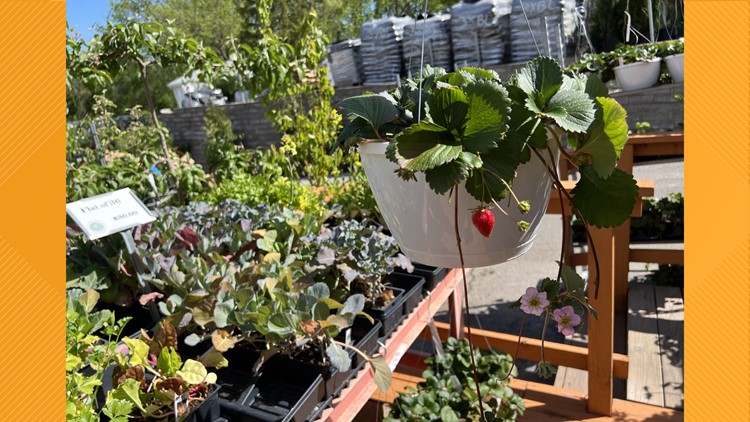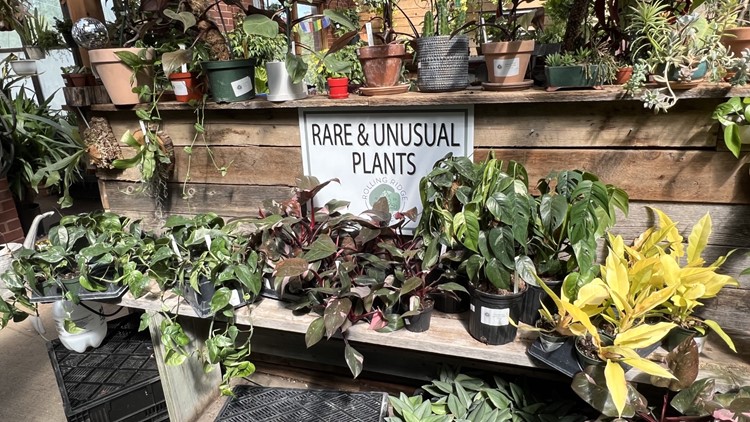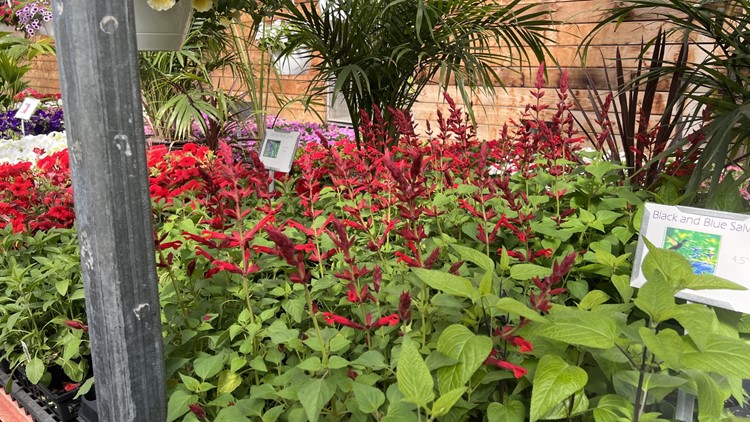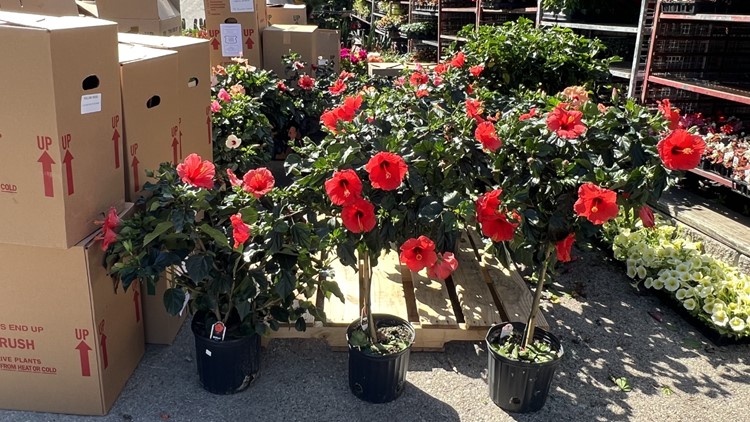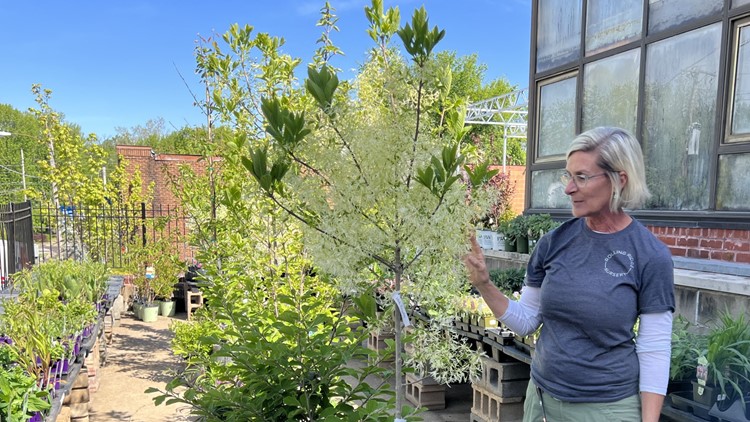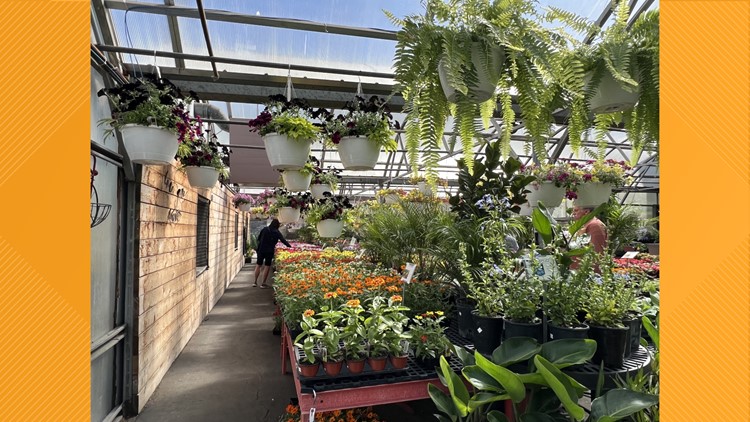WEBSTER GROVES, Mo. — May is here, and while most people have already had the springtime motivation to buy seeds and start a garden, they may not know what comes after the planting of seeds and building of garden beds.
To get some insight on the "next steps" on gardening for a beginner, or maybe a third- or fourth-time gardener who could use some more tips on how to maintain a garden through the St. Louis region's spring and summer season, 5 On Your Side sat down with Rolling Ridge Nursery.
Lynn Cressler is the President of Rolling Ridge Nursery, and she is what you would call an expert in the nursery biz.
Rolling Ridge Nursery was opened by Cressler's family in 1959. Nestled in Webster Groves on North Gore Avenue, Rolling Ridge has just about everything you could imagine for your gardening needs.
April and May are the busiest times of year for Cressler and Rolling Ridge. Walk into the nursery this time of year, and you'll find workers buzzing around maintaining plants out on the nursery sales floor, unloading the multiple trucks stocked full of new plants received every day, putting plants out for sale and assisting customers with questions and check out.
The nursery also has a custom planting department and sells a full line of herbs, fruits trees, vegetables, plants, berries, seeds, trees, shrubs, cacti and succulents, house plants and so much more.
Cressler said Rolling Ridge focuses on carrying plants that fit with the region.
“We focus on things that will give the homeowner success in their planting," she said.
The basics
To get to the basics of what options you have for gardening and planting this time of year, Cressler broke it down.
Perennial plants, which are things like trees, shrubs and rose bushes, are planted, have a short blooming period, go dormant and then return the next year, Cressler said.
Perennials can vary from sun perennials, shade perennials and native perennials, which means they would be native to a specific region or area.
Next up are annual plants. Annuals are usually flowers that can be found around this time of year. They die off after their blooming stages and do not grow back.
Many of the bright, summery flowers you see in hanging baskets and in nurseries and lawn and garden centers in April and May are annuals.
Cressler said annuals usually need to be planted outdoors and need a lot of air movement. She said after they die off, they need to be dug up and disposed of.
When you reach the spring planting season, the main thing you need to pay attention to, Cressler said, is the nighttime temperatures.
“They (temperatures) need to stay consistently in the 50s for a good week to two weeks for the soil to warm up enough, if you’re planting in the ground, to plant certain summer-loving, mainly annuals.”
She said most trees and shrubs can be planted any time of year, so long as you can dig a hole, because they don't mind cooler soil.
Types of soil
Different kinds of plants require different kinds of soil. Cressler said most plants need organic matter worked in when planting them into the ground.
Fresh organic garden soil, which can be found most anywhere that sells plants, is a good option to use when transferring a small plant into a garden bed or the ground. Garden soil helps the plant adjust to its new home.
Cressler said the reason for this is because much of the ground soil in our area is clay-like and very dense. Repotting a plant directly into the ground with no fresh soil would make it hard for the plant to continue growing and spread its roots.
Cressler compared using ground soil on its own to eating fast food.
“It would be like eating McDonald's every day. Mcdonald's once in every while is great, but if you were to eat McDonald's every day, you would start to suffer nutritionally. It’s the same for plants.”
She said it's important to keep the native soil there, but just to make sure to add something more nutritional for the plant, like organic garden soil or compost.
“That’s where the nutrients for the plant start. Healthy roots, healthy plant,” she said.
Cressler said if you're trying to determine the type of soil you have at your home, the University of Missouri Extension office in Kirkwood offers Soil Testing.
To test your soil, you bring in a sample and the office will analyze the sample to tell you what plants will need when being planted in the ground at your home. Cressler said the testing is also a great way to determine why something may not last in a certain spot in your garden.
Cressler said most organic matters will work to add to soil, but to watch out for manures because some may be too hot and dense for the type of plant you're repotting.
She recommends organic garden soil for most perennials. For trees and shrubs, she recommends topsoil and cotton compost. She said trees and shrubs need extra weight on the soil, and the compost helps bring that.
Cotton compost is a compost created as a byproduct of cotton burs cultivated from cotton fields.
Cressler said if you're unsure what kind of soil you need, you can always come in and ask. “Usually, our customers come to the counter, and they tell us what they’re doing, and then that way, on an individual basis, we can advise them.”
Products offered at Rolling Ridge Nursery
Repotting need-to-knows
Cressler said the time to repot your baby plants into the ground will depend on their height and strength. She recommends waiting until there are 3-5 leaf sections on a plant.
It also should have a substantial root system to ensure the plant will survive in the ground.
The number one thing to remember is to NEVER bury your plant when repotting.
“In general, you want to keep the top of the soil in a plant that you’re planting even, or a little bit raised from when you transplant it,” Cressler said.
The reason for this is to allow the plant to settle. If you bury the crown of a plant, Cressler said, it will suffocate and die. She also said to dig wider instead of deeper into the ground to allow the roots to settle.
After planting those small plants in their new homes, it may be good to add stakes to give them extra support, especially for any strong summer storms that may come your way.
“Staking, even if it’s just with a simple bamboo pole, is a great way to give a plant a fighting chance," Cressler said.
To adhere the plant to the stake, never use metal wire. She recommends twine, string or Velcro supports you can buy for this specific need.
Cressler said another way to protect plants in severe weather is to cover them. She said to use an old sheet of a frost blanket to cover the plants.
"Never use plastic," she said.
How to manage predators and pests
Insects and other garden predators are often a common problem in gardens in this region. Rolling Ridge offers a variety of different insecticides and pest control solutions to help manage some of the nuisances, Cressler said.
The hotter it gets outside, the more pests are attracted to your luscious garden.
She said the nursery offers system insecticides and granules, as well as topical ones. The systemic ones are longer lasting and get to the root of the plant, and the root of the problem, if you will.
Systemic options are slower moving, while topical sprays provide faster, but not as long-lasting protection.
When it comes to rabbits, deer and squirrels attacking your garden and plants, Cressler said there are ways to repel them, too.
Organic granules can help deter rabbits and deer, and there are plants that are marketed as deer and rabbit-resistant, she said.
She said the solutions may not always be foolproof, though.
“What one rabbit will eat in your yard, they won’t eat in your neighbor’s yard and what they’ll eat one year, they may not eat the next year. It’s a constant battle," said Cressler.
Lasting bits of knowledge and tips
Cressler said if she could recommend three tips to a first-time gardener, it would be these:
1. Don't overwater
"People think that they have to water a little bit every day, and that is not true. In order for a plant to grow, whether it’s a cucumber or an oak tree, the roots have to have air. They have to have oxygen to spread,” said Cressler.
She said it's OK to let things dry out before watering again.
2. Know sun exposure levels around your home
Cressler said it's important to watch where the sun hits around your home. “Know your exposure. Does your house face north? Does it get a lot of hot, afternoon sun in the back?"
She said oftentimes people will come in and want to buy a certain plant, but don't realize its specialized needs when it comes to sunlight.
3. Know your limits
Cressler said time management is big when it comes to plants and gardening. If you're a busy person with a busy schedule, but still want to grow a garden or have plants around your home, ask the nursery to recommend low-maintenance plants that don't require a ton of extra time and attention.
When it comes to resources, there are a number of great ones in this area.
Cressler said one of her favorites is the Missouri Botanical Garden. She said their website has just about everything you could need to know to garden.
Local university extension offices can also be a good tool, she said.
Cressler did recommend staying away from Google when it comes to plant needs. She said some plants that may be advertised as one thing in one place, may not be the same for where you live. She said regional resources are always the way to go.
“What’s perennial in Florida or California, is not necessarily perennial here.”
You can also reach out to Rolling Ridge Nursery. There's a contact form on their website that goes into an email inbox. Through the form, you can ask inventory questions, get help with your pre-existing plants and get recommendations.
Cressler said she and her staff also love when people bring in photos of their gardens and plants.
Cressler said if you're in need of help planning a big landscaping project or have extensive questions, it's best to come In the fall or winter. She said rainy days and the hotter summer months are also better times when staff can devote more time to helping you with large gardening needs.
But all the same, Cressler and her team appreciate all the love and support Rolling Ridge Nursery has received in its 64 years in business.
“There’s a lot of places that people can shop, from other nurseries to the big-box stores, and we appreciate everyone that steps foot through the door because we know they have a lot of choices," she said.
To learn more about Rolling Ridge Nursery, visit its website, or head into the nursery located at 60 North Gore Avenue in Webster Groves, Missouri.
To watch 5 On Your Side broadcasts or reports 24/7, 5 On Your Side is always streaming on 5+. Download for free on Roku or Amazon Fire TV.


